We all have gaps in our pop culture knowledge, those omissions that elicit gasps from our fellow funnybook connoisseurs. For me, those gaps are vast and constitute anything outside of DC Comics proper. I’m on a mission to rectify my comics knowledge shortcomings and to provide a fresh take on classic stories that others have known for years. The comics may be old but my mind is still fresh, wrapped in plastic and sitting on the shelf, waiting to be opened. Welcome to Mint Condition!
This time: I sit at the feet of the masters as I check out the very beginning of the Fantastic Four!
BACKGROUND
The skinny: If you don’t know about the Fantastic Four, I don’t know what to tell you. There’s a stretchy one, an invisible one, a big rock guy, and one who’s on fire. Does it make sense? No, not at all. But you’d be hard pressed to find a more influential Silver Age creation than this wacky quartet. This is the story that kicked off the modern Marvel Universe as we know it, and the start of a monumentally important collaboration between Jack “King” Kirby and Stan “The Man” Lee. Today’s comics have everything to owe to these gentlemen and their Fantastic Four.
Issues read: Originally, this article was supposed to be about Fantastic Four #44-60, which is a much-loved story arc in this run; featuring Galactus, the Silver Surfer, Doctor Doom, and the Inhumans. But a funny thing happened along the way. Having never read the FF, I went back and checked out issue #1 for context. It was FUN. Before I knew it I had read over 70 issues and had to wrench myself away from it. So screw it, I’m reviewing the whole damn thing.
Published by: Marvel Comics
Publication dates: Issue #1 came out in 1961. Stan Lee and Jack Kirby cranked this thing out monthly for years, all the way up to issue #102 in 1970.
Creators: Usually when I picture the creative workflow of a comic book, I think of a writer typing up a complete script and then sending it off to an artist for illustrations. It would be a mistake to think of Stan Lee and Jack Kirby in this sense. Yes, Stan is credited as the writer and Jack is listed as the penciller, but the truly collaborative process that these two came up with blurred those lines to the point where it’s more accurate to think of them jointly as the “creators”. I’ll also call out inker Joe Sinnott, colorist Stan Goldberg, and letterers Sam Rosen & Artie Simek, all of whom were steady presences on the book for dozens of issues through the best-looking parts of the series.
My previous experience: For all that talk about how immensely important FF is, I came into this one pretty cold. I’d seen the 2005 Fantastic Four movie as well as its 2007 sequel featuring the Silver Surfer, but I’d never read a comic. I could name the characters and give a surface-level description of each. I knew Doctor Doom was an evil dude with a mask and Galactus was some kind of space giant who wanted to eat the Earth. Honestly none of it ever excited me that much, as it all seemed so…random.
FIRST IMPRESSIONS
Significance: I wonder if Jack and Stan had any idea what they were building. At the time, what we now know as the Silver Age of comics was well underway, as rival DC Comics had a five year head start with their complete reimagining of characters like the Flash, Green Lantern, and others. When DC’s new superhero team, the Justice League, took off in popularity, Stan Lee (who was also the Marvel Comics editor) decided to get in on the action. Fantastic Four revitalized and essentially relaunched the line, becoming the backbone of Marvel Comics for years. This was the book that saw the first appearances of (get ready, this is going to be a long list): the Watcher, Doctor Doom, the Frightful Four, the Inhumans, the Black Panther, both the Skrulls and the Kree, Ronan the Accuser, Kang the Conqueror, Adam Warlock, Silver Surfer, Galactus…you get the idea. Even characters that were birthed in other books (Hulk, Avengers, Daredevil, etc.) each came to pay their respects in the form of periodic guest appearances. An entire universe was built on this house and the sheer amount of creativity flowing from Jack & Stan’s minds was staggering. This one is a piece of history.
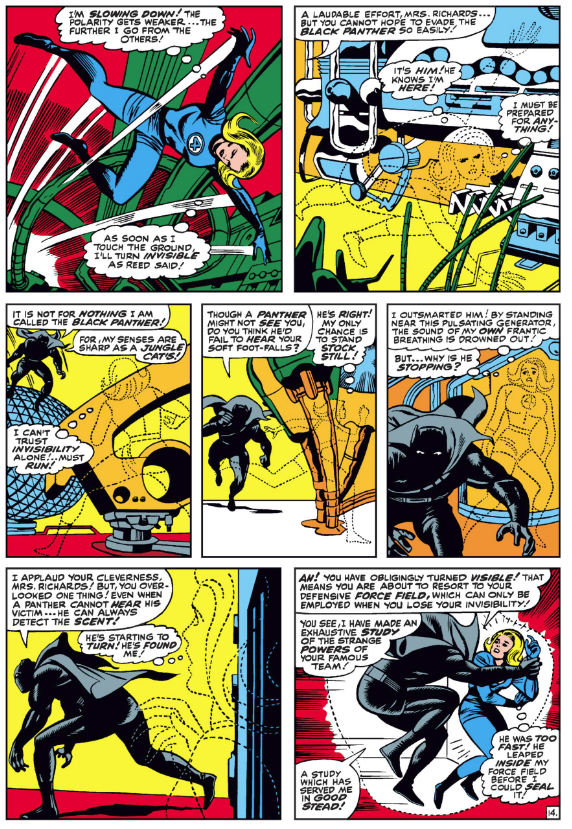
Everything about Fantastic Four is ridiculous. Deliciously ridiculous. If you’re wondering how four people got such dramatically different super powers from the same incident, the answer is simply “mysterious cosmic rays”. Don’t overthink it. Once the group is bathed by the cosmic rays in their tragic space accident, it takes no more than three pages for them to assess their new abilities, decide to form a super team, and head out to Monster Isle to battle their first nemesis. And it’s balls to the wall ridiculousness from there on.
For the first few years of its publication, Fantastic Four was almost completely episodic. As was the style in those days, a menace or mystery would present itself at the beginning of the issue and be resolved twenty pages later. Namor and Doctor Doom were frequent guest stars, but each issue offered a complete story that had little to do with the events of the preceding issue. And the ideas were flying — I count at least ten significant “first appearances” in the first fifteen issues, not counting the titular heroes. It’s really satisfying to see how these early single-issue stories plant the seeds for so many of the current Marvel mainstays.
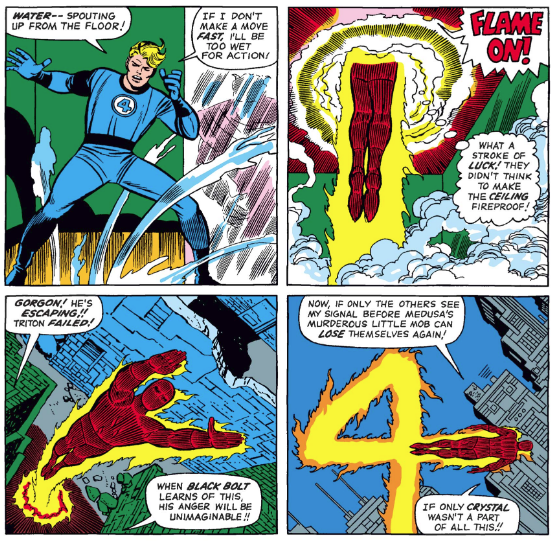
Something that’s present from the beginning of the series is the characters’ joyfully unique voices. Johnny Storm is a college kid who’s hunky and athletic and has a serious thing for hot rods. Reed Richards is the consummate scientist and researcher, prone to lecturing and often missing out on the fun of life as he obsesses over his latest invention. Sue Storm has to fight for equal footing in the boy’s club, continually reminding her husband Reed that she is capable of taking care of herself. But the real star of the book, in my humble opinion, is Ben Grimm, the “ever-lovin’ blue eyed Thing”. His constant quipping and over-the-top grousing make the book a laugh out loud experience. Ben has a short fuse when it comes to anything that isn’t punching bad guys. He’ll take no more than a moment to assess a situation before declaring IT’S CLOBBERIN’ TIME!
The sexism in the book is problematic. Reed has a tendency to send his wife away from difficult battles that he judges she can’t handle, and is prone to sentences like, “For cryin’ out loud, Sue, use your head for a change!” For her part, Sue deals with her distress by going on shopping sprees. I’m not sure what to say about it, except to remind myself that we’ve come a long way since the 1960’s.
Finally, a large part of the fun of this story is that Jack & Stan are constantly reminding you that you’re reading a story. The amount of fourth-wall breaking in this book is almost absurd. The narration boxes address the reader directly and apologize in Stan’s voice for switching scenes so often. In his downtime, the Thing can be found reading a Hulk comic book and commenting on how it’s not as good as the FF’s own in-story comic book. There’s also a carnival barker aspect to the entire publication, with each issue marked as an “Earth-shaking issue!” or somesuch hubris on the front cover, and often making even bolder proclamations like “Possibly the most daringly dramatic development in the field of contemporary literature!” These guys weren’t going for humility.
Art: It’s intimidating to critique or even attempt to describe Jack Kirby’s art. He’s such an ingrained part of comic book history and his work is so foundational to what we think of as comic book art. The style here is exactly that classic funnybook flavor — large flat blocks of bold color, extreme shadows and striking facial expressions. The pencils are very line-heavy in directing the eye toward action, with scores of sweeping lines that accompany every arm movement, flight path, or energy burst. His panels are densely packed, with the backgrounds typically very detailed. Most pages are some variation on a six-panel or four-panel grid, with each panel zoomed way in, almost too close to the action. Often, this close composition of the panel gives the effect of standing right next to the characters and looking at the scene from a bystander’s point of view. If the narration boxes remind you that you’re reading a story, the camera angles make you feel like you’re inside it.
Where Kirby really shines is in space. The Silver Surfer glides through the vast cosmos among beautiful orbs of planets and stars, with more circles than lines on the page and room to breathe. Every spaceship or alien invention looks like a gloriously convoluted entanglement of bizarre shapes and curves. You can see the beginnings of the King’s signature “Kirby Krackle” effect — the use of many small black dots to edge an image rather than a line, giving the sense of tiny explosions of popping energy or scattering debris. Every now and then (like once every five or six issues), Kirby will break up the classic house style by throwing in a single panel that looks like a photo collage printed on muted-tone paper. He usually saves this jarringly different technique to underscore a big reveal in space or a gorgeous underwater vista.
VERDICT
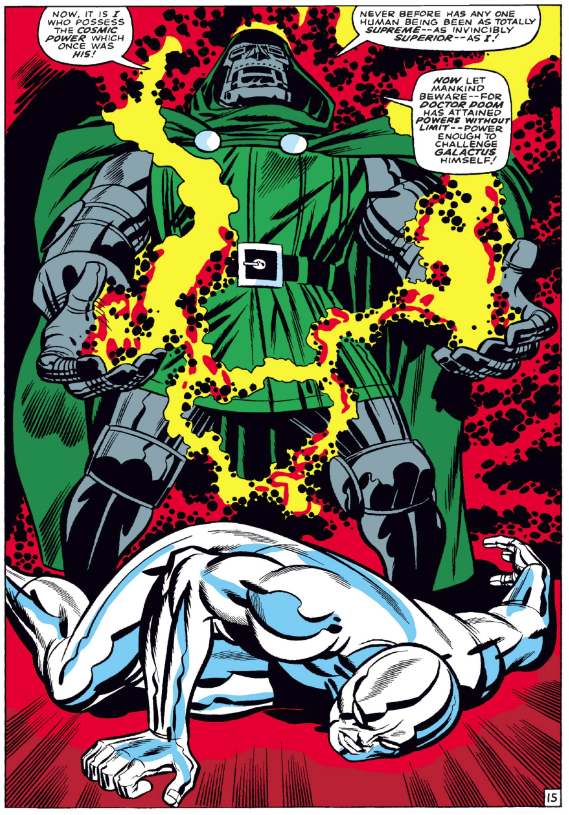
The absolute latest you want to jump into this book is issue #44, where we start to get really serious about Black Bolt & the Inhumans and Johnny Storm meets the love of his life. This is where we see the first appearance of the Silver Surfer, are introduced to the Black Panther and the nation of Wakanda, and really start to worry about this Doom fellow. Regardless of where you choose to begin, each issue is worth the 12-cent cover price, guaranteed.
Desire to read more: You can probably tell I thoroughly enjoyed this series. Maybe I’ll pick up the new book this summer!
Final Thoughts: To understand comic books, one must understand what Stan & Jack built. I’m really glad I started here, as a solid foundation for my ongoing Marvel exploration. Can’t wait to see what else I’ve been missing.
Want more? Check out the full column archive here!


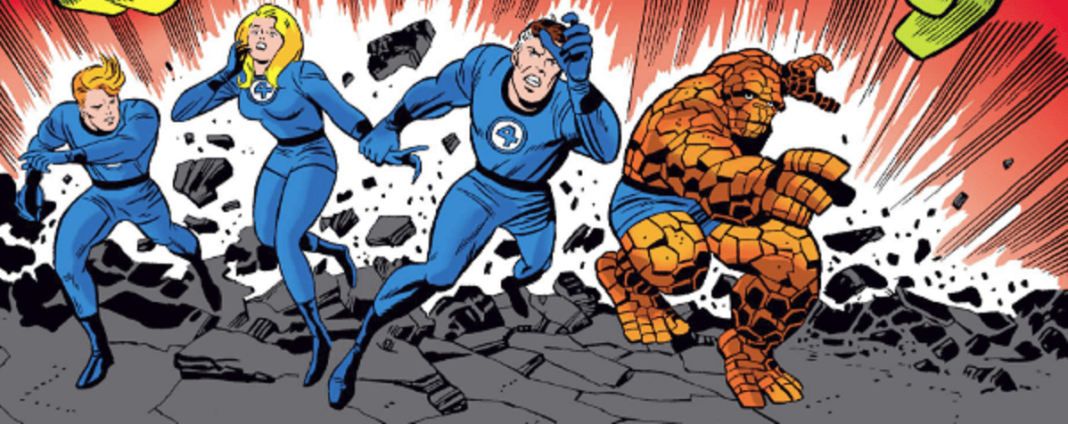
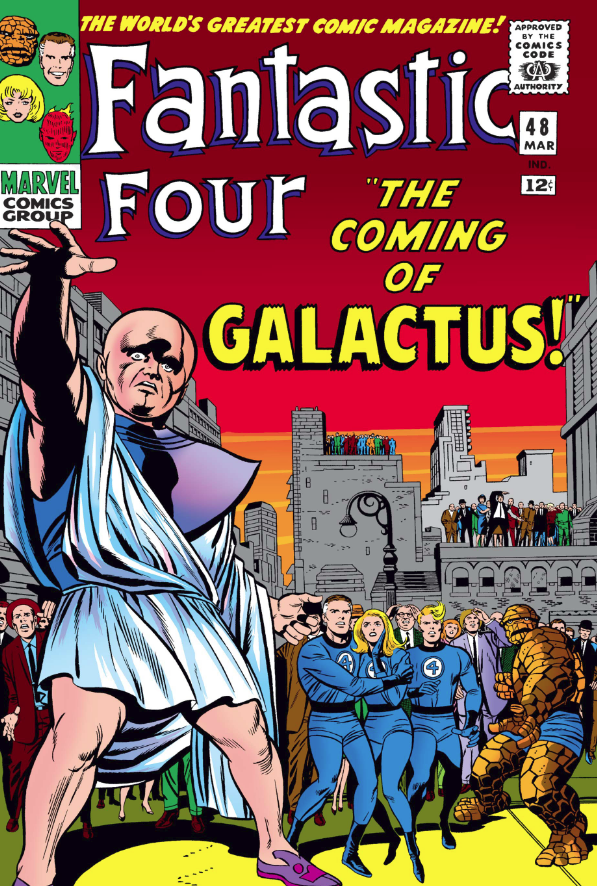

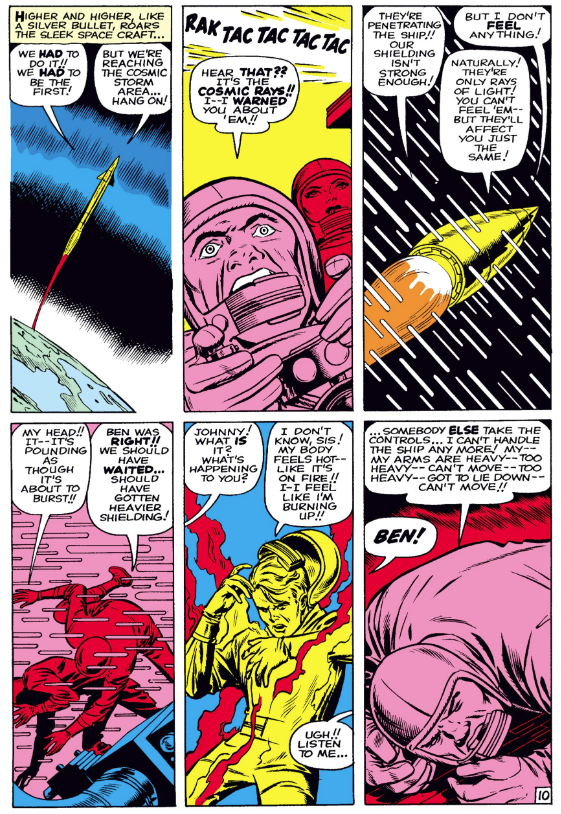
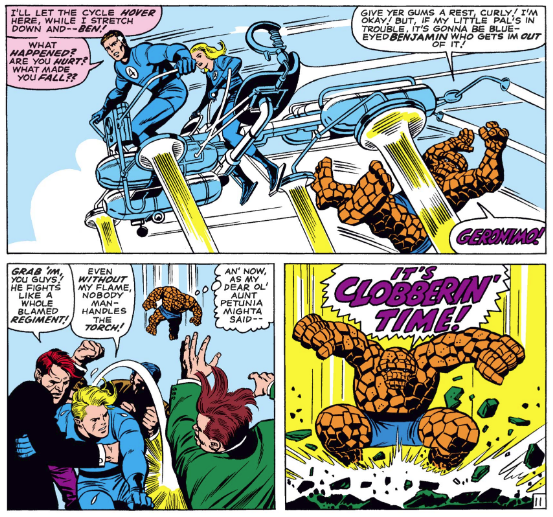
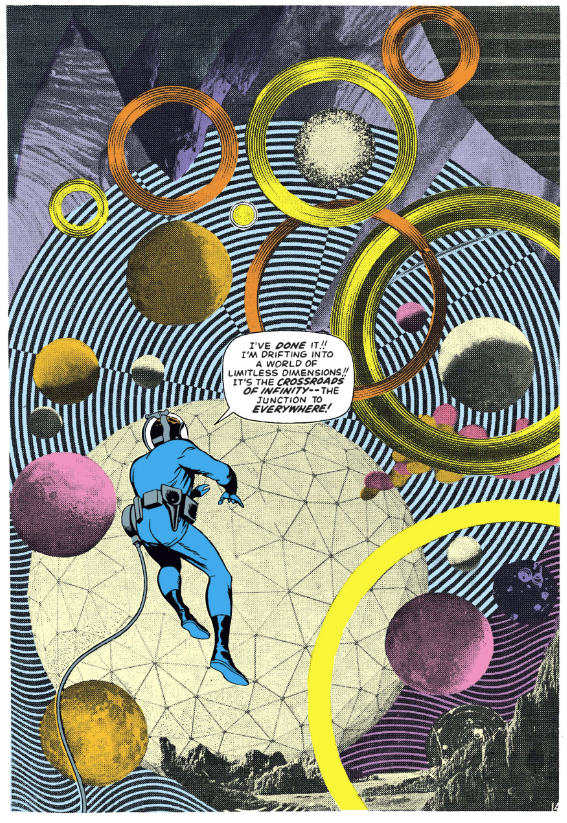
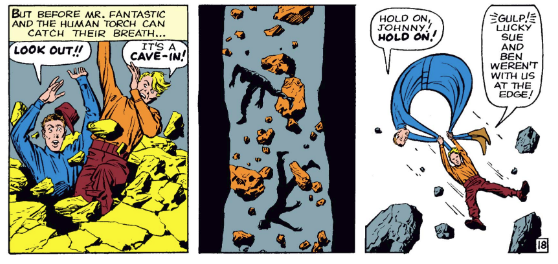
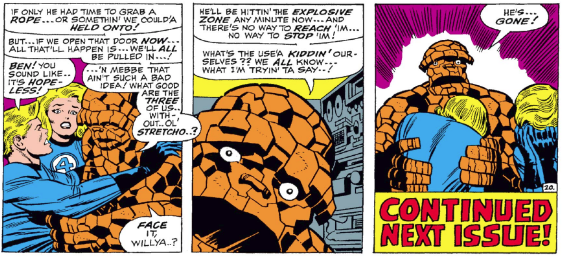

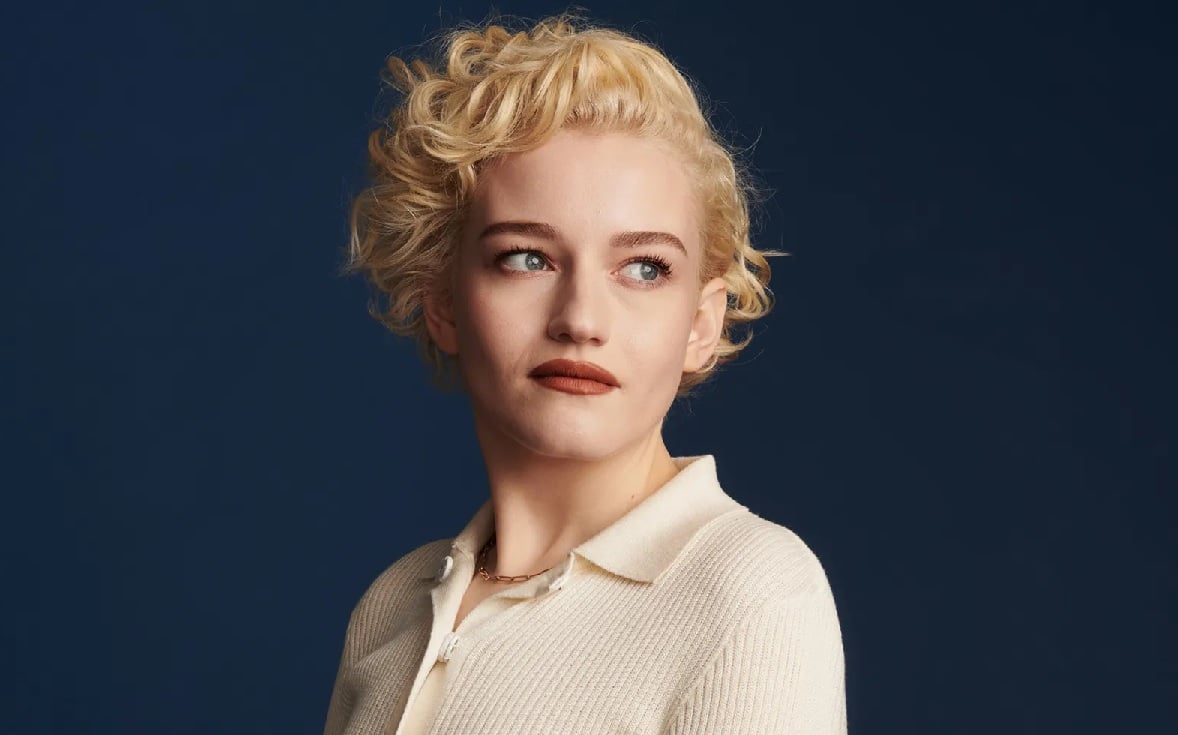
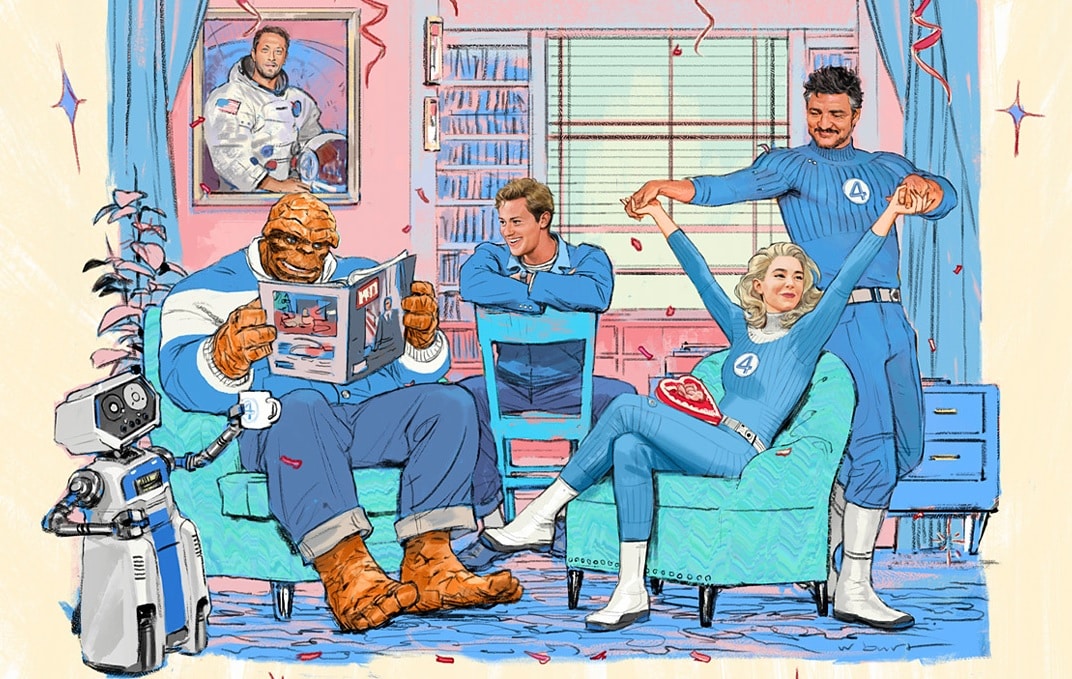


As much as you liked this, you have to check out Lee and Kirby’s Thor as soon as you are able. It is BONKERS.
In Fantastic Four number one Reed Richards steals the rocket he designed and helped build. He takes with him his best friend who’s also the best test pilot so that makes sense but he also takes with him his girlfriend and her teenage brother. After the ship crashes the authorities should have thrown the book at him but there’s no mention of his law breaking
This is great. Reviewing the old comics is interesting and enlightening. As a fan of comic book history (I buy almost everything TwoMorrows publishes) this satisfies that jones, for sure. The Galactus Trilogy is very good, but my fave of the run is #55, This Man This Monster. At this point in Marvel history, Kirby and Lee are a bottomless font of great ideas. A Big Bang of comics so to speak. Love it. Until next time…
Comments are closed.